|
Horse Agility and/or Equine Agility
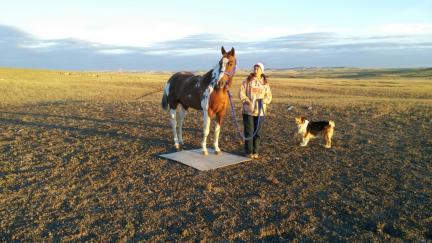
Equine = Horse, Pony, Donkey, Mule, Miniature/Mini Horse or Donkey, Draft, any horse type animals.
Agility = The Showmanship of Being Agile. AGILITY usually pertains to a Human and Animal Team Performing with Obstacles (jumps, barrels, weave poles...) and Equipment (bridges, tunnels, pause areas...) in a Timed Event.
ANY type of Equine has and can participate in Equine Agility. It does not matter if you are Just Having Fun on the Farm or Participating in Competition.
Safety is above all.
Any time you work with equine, or are around equine, there are dangers. Equine are very strong animals and things can go wrong. WE ARE GIVING YOU IDEAS AND INFORMATION ON THESE PAGES ONLY. WHAT YOU DO OR DO NOT DO WITH THEM IS UP TO YOU. YOU AND YOU ALONE ARE RESPONSIBLE FOR YOUR SAFETY, YOUR EQUINES SAFETY AND THE SAFETY OF OTHERS WHEN WORKING WITH YOUR OWN EQUINE. WE ARE NOT THERE. YOU ALONE ARE RESPONSIBLE!
A FUN AND FUNNY HORSE AGILITY TRIVIA FACT
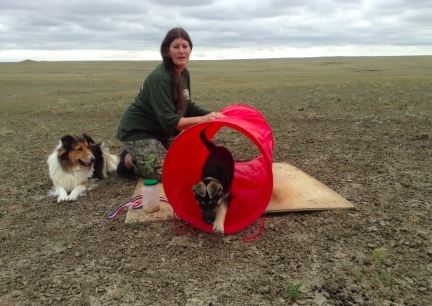
Horse Agility, the Actual Sport, that is, with Equipment called Bridges and Teeter Totters and Hoop Jumps, came along AFTER (time wise) the sport Dog Agility. Do you know where Dog Agility got it's start?
Dog Agility got it's start at a Croft's Horse Show. The Administrators wanted a fun event during the Half Time or Intermission so the sport of Dog Agility was started to entertain the people at the Horse Show...and the new sport, Dog Agility, took off like mad!
Things come Full Round....so I have heard all my life. And Horse/Equine Agility sure has.
Working Equine in an Agility Manner, with Training and Desensitizing....has been around as long as Man and Horse have been together.
Yes! That is our German Shepherd Dog (pup at the time) Titus learning a bit of Agility! With Raya, our Ranch Dog, watching on.
ABOUT US
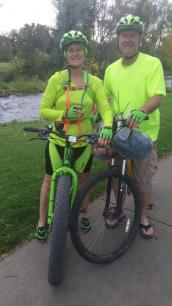
Deron, my husband, and I have trained animals for most of our lives. We own and train a lot of different species to do all sorts of things.
Animals we have trained to Agility include these animals Fish and Mice, Hamsters and Gerbils, Rabbits and Pet Rats, Guinea Pigs, Dogs, Goats, Donkeys, a Pony and Horses. And we have even trained a bit of Agility to Geese, Chickens and Ducks....yes, really. The first Trick Training with an animal I ever did was when I was 6 years old and the animal was a Chicken Hen.
We have also trained other animals, such as Llamas, but only to pack and pull carts, not to Agility...other animals we have trained, but not to Agility include, Pigeons, Parakeets, Cockatiels, a few Reptiles.... and I am sure I am forgetting some here....
Unfortunately when we moved we were not able to bring all of our larger Agility Equipment with us. So we are now rebuilding.
We have and do train our own Horses, Ponies and Donkeys...so Equine Agility? It was a matter of time for us to become involved.
When I told Deron years ago I wanted to train my Pet Rat, the first species of the smalls that I started working with, to do an Agility Course he asked what Pieces Of Equipment I wanted to use. He got out the Dog Agility dimensions (he had built all my Dog Agility Equipment) and "did the math". He then built the best Rat Agility Equipment I have ever seen! There was none around anywhere at the time he built ours. Mazes, but not Agility Equipment.
The same happened as I wanted to build Agility Equipment for other species of animals. And now he is "Doing The Math" for Horse Agility Equipment. I am surprised to not find information on "the net" for sizes and specs for Equine Equipment.
Please visit our Sister Sites listed at the side panel to the right and see Guinea Pigs, Dogs, Goats, Hamsters, Fish, Mice, Gerbils, Pet Rats, Rabbits, and more, of our animals performing in Agility. Photos and videos.
Oh. And we also do other things like Ride Bicycles, Kayak, Backpack, Swim and such.
HORSE AGILITY EQUIPMENT
When most people hear "Horse (or Equine) Agility", the first thing they want to do is see photos of the equipment. So I put this Subtitle First on our site. We will be adding photos of not only our own equipment but other ideas a person could use.
Some items/equipment used in Horse (Equine) Agility are as simple as Tarps, Logs, Poles, and Flags, Tires, Barrels, that you probably already have around your place. Just take your time, take all the time you need to take, to train your equine to become familiar with each item/piece of equipment as it takes your horse to become familiar and unafraid of each item before moving on.
Most people will be building their own pieces of Horse (Equine) Agility Equipment because buying it and having it shipped will cost a near fortune.
We plan to add (below) specs and photos of ideas you might use to get yourself and your horse out working on new things....Agility.
Keep in mind that most Animal Agility Courses have at lest two to three (or more) Jumps set up, but not in a row. Try to set up a few different types of Jumps for your Equine Agility Course.
Equine Size Matters!
Yes. It Does Matter, the size of the equipment.
You would not want to use the same sized Agility Equipment for a Miniature Horse or Donkey or Mule as a Full Sized Quarter Horse Equipment. Nor would you want to use Agility Equipment made for Minis for your Draft Horse.
Just like with Dog Agility there needs to be different sized Horse Agility Equipment for the Different Sizes of Equine.
On that. Dog Agility Equipment is not made for Mini Equines. Some of the Dog Agility Equipment Jumps could be used, but any thing that is stood on or walked over is not made for the weight and hooves of the equine. Build EQUINE Agility Equipment for Equine.
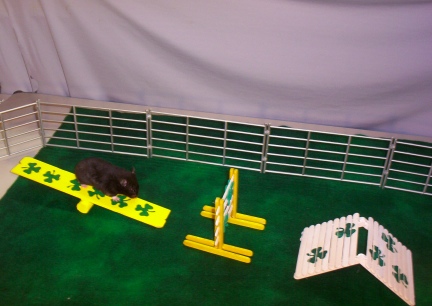
What Types Of Agility Equipment Is Used For Horses/Equine?
How Big Is Your Imagination? What Pieces Of Agility Equipment Have You Seen That An Equine Could Safely Use?
Equine Agility Equipment is some of the same used for every other type of animal that enjoys agility. And there are added Equipment Pieces I have seen Equine used based on their "fight or flight" nature. Items such as the Hanging Flagging Tape, a Box Full Of Water Bottles, the Tarp on the Ground to Walk Over, the Flag Tunnel, and such. Many brought over from "Obstacle Courses". (and to me, not agility)
For the most part, and mostly the advanced trained animals, are using Pieces we all recognize. The Jumps/Cavlettes, a Teeter Totter, Tunnels, Pause Tables/Pedestals...
And everyone's favorite....the Tire or Ring Jump. Humans love to see Animals Jumping Through Hoops!
This is a photo of one of my hamsters on Agility Equipment everyone loves and recognizes.
Agility Equipment vs Obstacles - There IS A Difference!
My only dismay with "Horse Agility" is that they use too many Desensitization and Trail Class Obstacles. If you are going to call it AGILITY, make it AGILITY. Not a Half Agility = Half Non Agility Obstacle Course.
Agility Equipment, listed above IS Agility Equipment.
Desensitization Obstacles are as follows:
The Tarp
The Boarded Up Square Full of Empty Water Bottles
The Flag Tunnel or what some call the "Scary Place"
The Hula Hoops
Those that Border:
The "Curtain" (the Frame with Hanging Strips of Fabric or Plastic or Noodles)
The Water Pool
OBSTACLE TRAINING IS WONDERFUL AND WILL CERTAINLY TAKE SOME TRAINING FOR THE HORSE, TRAINING YOUR EQUINE TO OBSTACLES BEFORE AGILITY EQUIPMENT IS HIGHLY RECOMMENDED. BUT IF YOU ARE GOING TO CALL IT "AGILITY" MAKE IT AGILITY, NOT AN OBSTACLE COURSE OR HALF OBSTACLE COURSE.
IS YOUR EQUINE READY FOR AGILITY COURSE TRAINING?
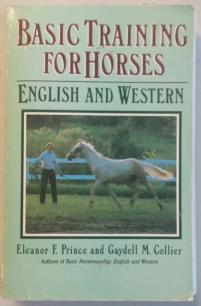
Be Honest. Is your horse ready to be trained to the Real Equine Agility Equipment?
How well trained is your equine? How well would YOUR Equine do if entered in a Western Trail Class in a Horse Show? If you do not know what the Obstacles they use are, please go and look it up. If you equine would not be able to quietly go over the items and or obstacles in a Trail Class, and or quietly load into a Horse Trailer, THAT!, is where you should start, BEFORE you introduce your Equine to Agility Equipment.
The book in this photo is one of my favorite training books. It is straight to the point, no nonsense training. This book has everything from Ground Training to Riding and Driving as well as Packing Training and much much more. It is well written and easy to understand. My copy is worn and torn and taped and has many notes inside of it written by me as well as multiple paper clips at the top of several pages marking areas I use often.
I own and have read MANY Horse, Donkey and Equine Training Books. There are a lot of good ones on the Market. There are a lot of "not so good" ones too. Find some good books and read them. Learn about equines. Learn about how to act and move around them. Learn how to train them. Learn.
Deron and I have trained several horses from wild, off the range, colts, bringing them up to be well broke, well mannered, riding horses. We have trained equines to do Tricks, Agility, Driving, Packing, and more. One thing I repeat, for a reason, over and over, is to take your time and train correct.
Training Equine is not Rocket Science, but it takes a LOT of commitment and time. You have to be consistent and always the leader to your horse.
My point here is, if your horse is not ready to learn REAL AGILITY EQUIPMENT, start with the basics. Take your time. Teach your horse the Trail Class Obstacles and go from there.
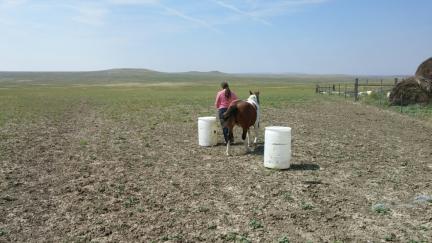
YOU DON'T HAVE AN ARENA?
You Don't Have A Fenced Area or Arena to work your equine inside of?
ME EITHER! That's ok. Work Your Equine on lead and go from there. You can still compete with your equine on lead... go from there is you get really good at this and you want to work off lead.
You MIGHT be able to just section off a potion of your Agility Area and your Equine will stay right with you....with lots of training. Hang In There on the Training and Working Your Horse with the Agility Equipment.
BUILDING YOUR OWN HORSE/EQUINE AGILITY EQUIPMENT ~ DIY ~ Homemade/Hand Crafted
Whenever, Whatever you build, it has to be strong enough for your horses strength and weight. Build wise. And Build to last.
Never use items that someone might say: "It'll do." or "Should Work" or "Let's Just Try It/This". Your animals count on and trust you. Do NOT let them down with equipment that might break or spook your them. Over building is well worth it. Use the correct materials and reinforce everything.
If you are going to build Agility Equipment, if you are going to Spend The Time and Money, Build to the Standards set for Competition. You might not be thinking about competing with your equine. But if you are going to do this, do it right the first time.
Many of us start out doing an event with our animals as a "Just For Fun" thing...then we find that not only do we really enjoy the sport, but our animals also enjoy the sport, and the human and animal as a team are really good at the sport...then they DO want to compete.
And a couple more reasons to build correct to Standard for Competition:
If you build your equipment right, correct, you are ready to Compete if you decide to.
If you build your equipment right, correct, if you invite others to join you with their equines they will be thrilled (and confident the equipment is safe) to come and join you for the fun!
If build your equipment right and correct and find that you really do not use it, don't enjoy it, no longer want or need it, you could actually sell it for at least the money you have into it.
AGAIN. WE ARE NOT THERE TO SEE WHAT YOU ARE USING FOR YOUR EQUINE ON YOUR AGILITY COURSE. THESE ARE JUST IDEAS AND INFORMATION THAT WORK FOR US WITH OUR OWN EQUINE. YOU ARE ON YOUR OWN. IT IS UP TO YOU, NO US, TO JUDGE THE ITEMS YOU USE FOR YOUR OWN EQUINE. WE ARE GIVING SIZES AND IDEAS. THAT'S IT. WE WILL NOT BE HELD RESPONSIBLE FOR ANY ACCIDENTS OR ACCIDENTS.
THE TARP ON THE GROUND
A Tarp On The Ground...is just what is says. Buy or find a Tarp, small is best, and place it on the ground. One each of the four sides set something safe for your equine to walk over unto the Tarp. All sides and corners should be covered and long poles, logs are recommended for holding the tarp from blowing and spooking the equine. You do not want the poles/logs to be to thick. Just enough to hold the Tarp still, and short enough for the equine to easily step over.
TWO HOOPS ON THE GROUND
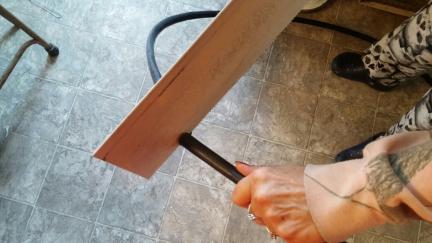 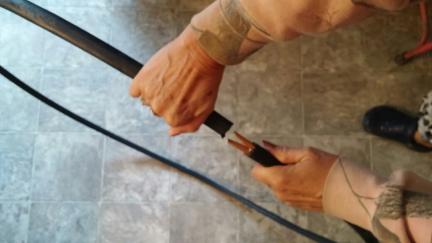 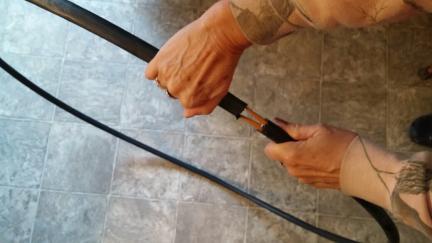 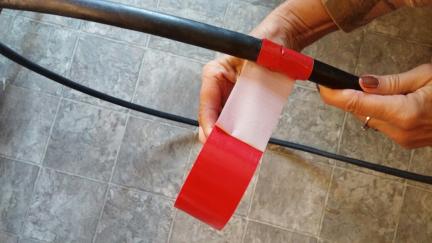
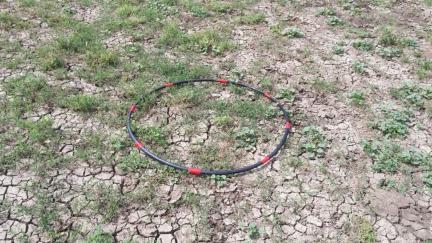
These two Hoops are the same type used to Hula Hoop. You can buy them cheap enough. Or. You can buy Black Hose from the Hardware Store. Cut a piece of Wooden Dowels to fit into each end to hold the circle tight and secure, and add duct or electric tape to hold. I used, rather than the Dowel, a Clothes Pin. They work well, and I had them here.
By making these yourselves, you can make the size you would like to have. A smaller one for a Mini, or a larger one for a Draft.
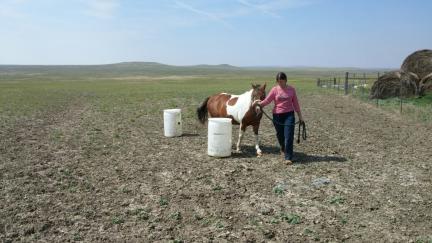
DOUBLE BARREL FIGURE EIGHT
Do you Barrel Race? Drag two of the Barrels over and use them for moving your horse around in a Figure Eight. If you have a smaller horse/equine you could use a smaller barrel. We picked up several 30 gallon Barrels from the Car Wash in town for FREE!

Other Items that could be used, to get you started, are large buckets, laundry baskets, two stumps, or the like. Just make sure on a windy day they items are not blowing. That includes the barrels. You can put a bit of sand in them.
STANDS FOR LEGS OF EQUINE AGILITY EQUIPMENT
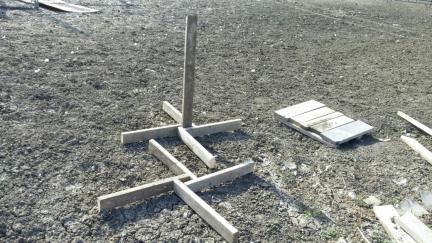
To build an Agility Course you will need Agility Equipment. To hold up your Jumps and Tunnels and such you will need stands to put your Uprights into. These are some that I made. Believe it or not, I used a Midar Box Saw and I 'eyeballed' the dimensions. I used the first piece of 2" x 4" to measure the rest off to make them the same size.
I took a small piece 2" x 4" to hold within for measuring how to screw the pieces together.
If my Husband, Deron, would have made these he would have measured everything and used the correct power tools. But mine worked.
I will add measurements I used.
FLAG TUNNEL
A Flag Tunnel is not really a Tunnel as we think of a tunnel. A Flag Tunnel is more of a Chute with Flags attached. How many flags? Start with one, add from there. Sizes of flags? From what I have read and seen, different sizes, all at once. Different sizes down the Chute, along the Chute.
A Chute or Flag Tunnel can be built using Wood or PVC Pipes. It must be sturdy and hold fast when flags are blowing in the wind (no shaking or bending). It must be wide enough for an equine and trainer to walk through together. And it must not be so lowly built the equine could step or jump over it.
Sizes are coming when we can find Specified Sizes for competition or see what makes since for equine sizes.
STREAMER STAND - also called - THE CURTAIN or THE CAR WASH
This is an interesting Piece. It is a Stand with Streamers...basically, that is it.
MAKE SURE, AS FOR ALL OF YOUR EQUINE EQUIPMENT, YOU HAVE VERY STURDY STANDS FOR THIS PIECE. If your equine "goes sideways in this piece, it might still have "creepy crawlies" on it (the streamers) and it might take the entire stand down. With good strong frame and stand, your equine is more likely to "get away" without taking the piece with it.
For the Streamers, you could use Fabric or Plastic Streamers, any color, and hang them from a Frame. You might want the colors to match your other equipment.
Your Frame should be approx. 7' Tall and 5' Wide. You could use wood or PVC.
We are using PVC so that I can take it apart for storage, and bring the "curtain" inside for storage. Leaving your Streamers out in the wind and weather will tear it up quickly. The way the wind blows here in NW SD the wind could take the whole piece down, and ruin it, if left together and outdoors.
THE FRAME:
You need good strong, study Stands to attach the Frame too. Remember, your curtain will blow in the wind and an unstable stand(s) could knock over...not to mention a horse going sideways in the Frame. Sturdy Stands, a MUST.
If you build the Frame from wood. Please add "corner pieces" at the top two corners for stability. These need to be cut at an angle.
If you build your Frame from PVC Piping, buy the proper corner pieces when you buy your pipe. Make sure they fit all together. If you need help when in the Hardware Store....ask. The Employees are trained for such things.
Buy all the materials you need. Build your Frame, Correct, Study and make it as attractive as you can. Buy making this right/correct, it will be inviting and enticing for others to start enjoying Horse Agility....and your photos will look better.
THE FABRIC
I bought some not so fraying when cut, seems to be Waterproof, Red, Fabric for $1.00 per yard. I bought several yards. The Curtain needs to be at least 4' long, and you might want it a bit longer for shorter horses/ponies/minis. I bought enough for that, plus enough to replace it down the road after wear and tear.
Depending on the diameter of your PVC or wood, sew a hem in the top of your fabric long ways...not across, but the same way they cut it for you when you bought it. Unless. You bought a fabric that is OVER 4' wide. Some Cordoras DO come that wide. Just pay attention before cutting...and on that...
MEASURE TWICE AND CUT ONCE. Don't forget to factor in your hem amount (of fabric you will need to add to the, at least, 4' of fabric) before cutting.
After you have your hem sewn into your fabric and you have tried sliding your, now curtain, onto your top pole...then cut your strips. Your strips should be about 1" wide.
Other items you could use for "the curtain"... An actual Shower Curtain (and the shower curtain holders), Flagging Tape (that will take some time), And old Flat Bed Sheet. I have seen photos on the Internet of folks using Pool Noodles (I can't say I like that idea so much, but they would blow less than fabric or plastic ~ to me however, this is a different piece of equipment).
THE PEDESTAL (also called The Podium or The Stand or Pause Table)
This is a tricky one. One you really need to be careful with. You so not want the Pedestal too tall, it will make it top heavy and it could tumble with the horse's weight, or when the horse steps up on it.
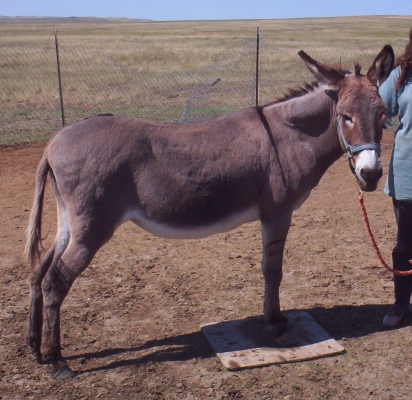
There are a LOT of different Pedestals that a person could buy or build. I could not find Dimensions for one used in Competition. Be sure to make it large enough for the horse, but no so big the horse can not move around it with front or back feet up on it as it "goes round".
We will be adding photos of our own 'real' Pedestal here soon
Build Strong, Sturdy and Correctly
When you deworm your equine you need to know how much it weighs. Remember that, think about that, use that information, when you build your Pedestal. Keep it in mind with every board or type of tire you look at and use to build your piece.
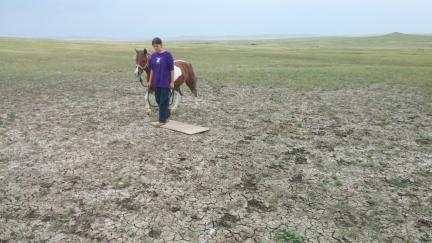
Ours?
We start with a piece of board on the ground....we train that and train that well.
Then we built a low to the ground and slightly larger than the one we will use later Pedestal out of some lumber we had here.
Wooden Pallets
DO NOT USE A WOODEN PALLET AS IT IS WHEN YOU PICK IT UP FROM THE PLACE YOU GET YOUR WOODEN PALLETS!
IF and I mean, think, and IF you use a Wooden Pallet, buy a lot of thicker, wider, boards to reinforce and build it up.
There are so many KOOOOL, KOOOOOL, KOOOOOL thing you can make using Wooden Pallets. Many Farm Items and Pens and Cages....but for a Horse? Not such a good idea.
That said. There are a few Wooden Pallets out there that are smaller and built using real Wood. That Is. Some are made, hard to find and few between, that are made with 2 x 4's and 2 x 6". Beefed Up. Reenforced. These might work for some equine.
JUDGE FOR YOURSELF IF YOUR PEDESTAL IS STRONG AND OR LOW AND OR BIG OR SMALL ENOUGH FOR YOUR OWN HORSES USE.
more to come
TWO or FOUR BARRELS - TIGHT SPACES also called LEADING THROUGH NARROW GAP
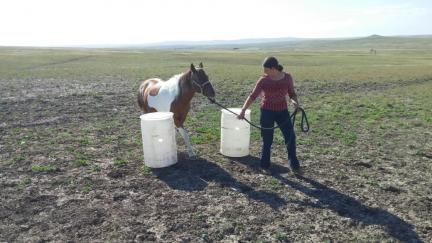
This one is easy for anyone. I recommend Two Barrels. When training, starting to train this Obstacle or Piece, keep the Two Barrels wide, move them in closer as the equine settles into the idea. However, MOST equine will walk right though without hesitation from the get go.
This photo and the one below is of my Paint Pony Dream Maker...I am smitten with her.
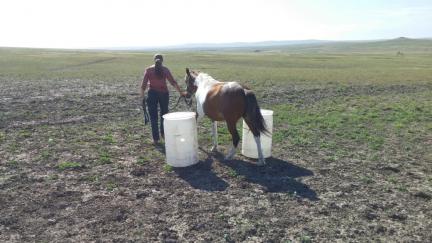
Deron and I get our Barrels FREE from the Car Wash Place in town. If you do the same, get more than you think you will need. Use 2 or more for "Tight Spaces", 2 for "Figure 8", and you could even use 5 more for "Weave Poles". Or use many with Flagging Tape for your "Scary Corner" or even, if you can haul enough barrels, to use as your fence around your Agility Course.
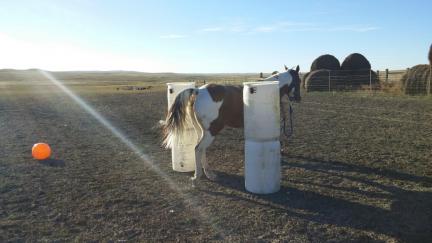
As the Sport Grows I think you are going to find that some of the Horse Agility Clubs will use TWO Barrels, and for training, Two Barrels is how you should start with Ground Training, and some Horse Agility Clubs will use Four Barrels. Two sets of two, one on top of the other for Height.
But because of Sport Growth and Changes, other clubs will recommend this for Ground Training and might ask for it to Qualify, but this type of "Agility Piece" will not be concerned Horse Agility Equipment.
This is my Paint Horse Arrow going through Four Barrels with plastic Spiders attached to them for Halloween Decor.
BRIDGE also known as THE DOG WALK
For Equine, THIS piece is going to be big, need to be built very strong and sturdy, have no wobble, and will be permanent, so chose where you build it wisely. This piece needs to be large enough that a large horse has room on it to move safely.
much more to come
THE A-FRAME
A-Frames for Equine are NOT built like A-Frames for other species. You will not want a peaked piece of equipment, but more of a ramp, then platform, then ramp.
Like the Bridge, THIS piece is going to be big, need to be built very strong and sturdy, have no wobble, and will be permanent, so chose where you build it wisely. This piece needs to be large enough that a large horse has room on it to move safely.
This piece also needs to be a bit wider than other pieces of Equine Equipment.
more to come
THE NOODLE GATE
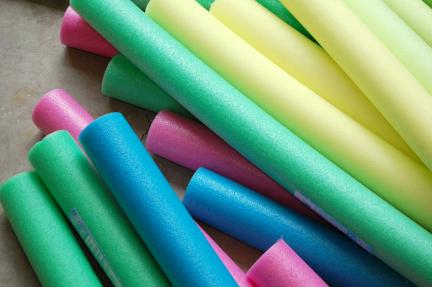
NOODLES. No. Not the type your eat, called Pasta. Noodles; as in the Pool Toys. This piece of Equine Agility Equipment is made for the equine to walk between.
Not only can Noodle Pool Toys be used, but also a cheaper item, Pipe Insulation, found in Hardware Stores, can be used. Pipe Insulation comes in one color, gray. It can however, be decorated.
Or, Like me, you can go to your Local Dollar Store and get Colored Pool Noodles to match your other equipment. I paid $1 each for mine....and the Noodles can be used for all sorts of other Horse Agility Equipment too....so I bought 20 to start and plan to go back.
This is ONE piece of Horse Agility Equipment that a couple Free Wooden Pallets, sturdied up, could be used to make your Noodle Gate. Using the Wooden Pallets for the side panels that hold the Noodles in Place.
KEEP IN MIND, YOU WOULD LIKE FOR THESE TWO SIDES TO BE INDEPENDENT OF ONE ANOTHER. With each side being "stand alone" you can train your Equine by starting the pieces wide apart, moving them closer as you train.
more to come
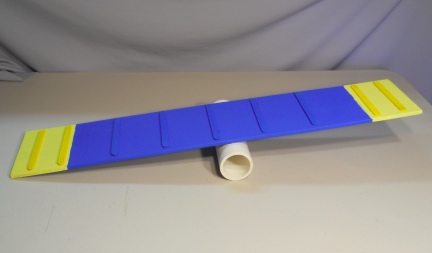
TEETER TOTTER (not SEA SAW)
Most people do not know the difference between a Sea Saw and a Teeter Totter Agility Pieces, and there is a HUGE Difference from the Animals and from the Trainers Eyes.
The first photo here is a photo of our Guinea Pig's Teeter Totter. A Teeter Totter has a low, log like, pivot. All pivots on Teeters are set just a bit off center or staggered middle of the board so that the Teeter or Sew Saw reset when the animal finishes the crossing of it. Note that the Teeter Totter rocks, it is kept low and easy.
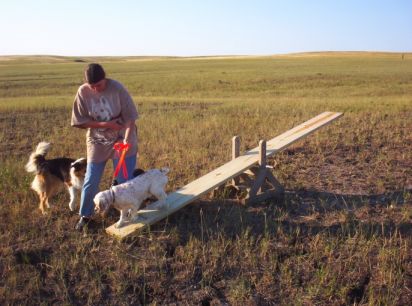
The second photo is of Frankie, our Cocker Spaniel, learning the Sea Saw.
A Sea Saw has a built pivot box or stand. The box or stand holds the staggered middle or off set top board for a Higher, Harder, pivot when the animal walks over it.
The Sea Saw takes far more training and is more dangerous, and if built for an equine would weigh a ton!
Each the Teeter Totter and the Sea Saw need to be walked to the end. That is why you see the yellow on each end of the boards. Any Competing Agility Animal must walk to at least where the yellow starts to not be disqualified.
An Equine should only use a Teeter Totter. Not only is it lower to the ground, it is safer for the large animals. A Sea Saw needs a Pivot Box. I am not sure how a Pivot Box could be built to hold the weight of an average sized horse with use over and over and over. I am not saying this could not be done...but. Then there is the training to the Sea Saw...and I know some people will want the Sea Saw for their Equine, just because I said it is not a good idea.
When You Build Your Equine Teeter Totter
When you build your Equine Teeter Totter make sure your Top Board, that is the the long piece the Equine Walks On, is built very Strong and Stable. There will be a lot of pressure placed on that Top Board, especially where the Teeter/Fulcrum comes into it. However, keep in mind that because of the way the Top Board sets, with the Equine walking over it, there is a lot of lever pressure on that board, more than your flatter boards that the equine walk across.
The Teeter Totter should be approx. 12'long x 30" wide for the averaged size horse. A Pony or Mini/Miniature Horse or Donkey could use a smaller sized Teeter Totter, while a Draft would need something just a bit bigger...and made for a Mac Truck to go over.
It is a good idea to cover the top surface with a non slip cover...however, if your Teeter Totter is going to be stored and used outdoors keep in mind that if you cover it with, ANYTHING, the rain is going to rot the wood underneath. Carpet will HOLD the wet and moisture on the boards.
When making your Teeter Top Board it is a good idea to add to stops on the underside. (more information and photos coming) By doing this you will be able to start with a smaller Teeter/Fulcrum, then as your Equine learns this piece of equipment, you could change out and use a larger, thicker, bigger circumference, under it.
TAKE YOUR TIME TRAINING THIS PIECE. DO NOT GET IN A HURRY OR GET COCKY BECAUSE YOUR EQUINE WENT ACROSS IT ONCE. YOU MIGHT FIND THAT THE NEXT OR THE FIFTH OR 10TH TIME YOUR EQUINE CROSSES THIS PIECE OF EQUIPMENT, IT DECIDES....IT IS SCARY!
more to come
THE ROCKING HORSE
And then there is The Rocking Horse Piece. AND EVERYONE LOVES THE ROCKING HORSE PIECE.
KEEP IN MIND, THIS PIECE IS AN ADVANCED PIECE OF EQUIPMENT. MUCH TRAINING, BOTH GROUND AND AGILITY TRAINING, WENT IN BEFORE THE EQUINES WERE TAUGHT THIS PIECE.
What is the Rocking Horse Piece of Agility Equipment?
It is a Piece somewhere between a Teeter Totter and the Sea Saw (seesaw). It is made strong, study and with a lot of reinforcing. It is a shorter piece that the Equine ROCKS by moving slightly forward, slightly back. Again. Don't hurry your equine to this piece. I know I say it a lot on this page, but PLEASE don't hurry your equine on the Agility Equipment. Take your time. Take the time it takes.
more to come
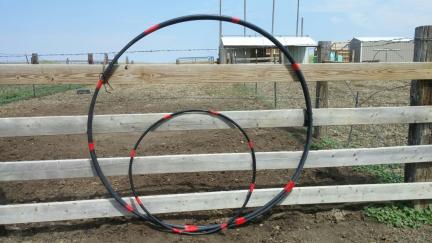
HOOP JUMPS
Hoop Jumps can be made out of a variety of materials. To make one for an Equine make it large enough for the size horse you are making it for. As the equine learns the Hoop Jump you can close the hole down a little by little to make a smaller. This is a photo of how we made our Beginner/Training Hoops.
...more photos coming of different Hoop Jumps
It is a very good and a highly recommended idea to make your Hoop Jump a break away. That is to make it so that it is in two pieces, broken horizontal.
more photos and information on the Hoop Jump coming soon
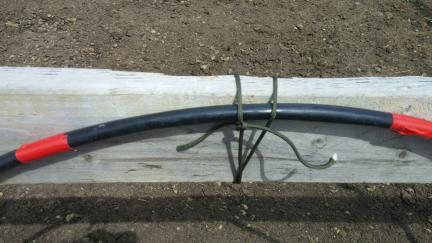
Since I store my Equine Agility Equipment outdoors and I want it to be safe, this is how I tie the Training Hoops to my fencing to keep them out of the way and safe from hooves.
LOG JUMPS
Log Jumps can be just that. Logs on the Ground for the Equine to Jump over...
more to come
WING JUMPS
Horses have been jumping Wing Jumps for yeeears. What is a Wing Jump? A Jump made with an addition on each side, many times the Wings look like a big Wooden Fan.
The Wing Jump is a favorite in all types of Agility. Some how the Wings make it seem like the animals are jumping higher. It is an Optical Illusion.
The Winged Jump is a piece of Equine Agility Equipment used only with equine at liberty, that is, off lead. Otherwise, much could go wrong.
more to come
CAVALLETTI JUMPS
These are Jumps you typically seen in English Horse Jumping, Dressage, or in Show Jumping. You will see these Jumps on many Training Courses. They have an X at each end of the jump that the pole sets into. They are low to the ground and "break away".
IF YOU REALLY WANT TO LEARN ABOUT BASIC HORSE AGILITY AND TEACHING YOUR HORSE TO MOVE PROPERLY. IF YOU WANT TO LEARN ABOUT EQUIPMENT PLACEMENT....STUDY UP ON THESE CAVALLETTI TRAINING JUMPS AND HOW TO USE AND SPACE THEM. I will not go into all the details of how these Jumps can teach you about training horses for Agility, but I will give a few basics.
These Cavalletti type Jumps can be easily made with wood or PVC pipe.
These can be made relatively inexpensively. You do not need to make these fancy, only Safe and Functional. They only need to be made 6' wide for Agility Training and use. They can be painted, decorated, or just left as the wood came. Painting them to match the rest of your Equine Agility Equipment makes for an attractive set up and nice photos.
Placement is everything. For the average sided horse these should be placed, measure please, for a Walk, 2 1/2' - 3' apart, for a Trot,4 1/2' -5' apart, and for the Canter, 12' apart. The idea is between each Jump, the horse comes down, right between them. You should take your horse through 3 or 4 Jumps, then look to see where the equines prints are on the ground. You might need to adjust the Jumps.
more to come with photos
BUSH, FLOWER OR FAUNA JUMPS
These can be as simple as Artificial Flowers lined up on a 6' 2" x 4" or an elaborate Jump with Ivy, real or fake, woven into Lattes (woven like a pie crust) Wood.
I bought 4 Fall sets of Artificial Flowers at the Dollar Store. Fall colors because I am getting ready to set up a Halloween Themed Agility Course and Video Taping it with Dream Maker and or Arrow. The Flower types and colors can change with the seasons by just purchasing new, and changing them out in the holes on the board.
A person could make the Flowers or Fauna as thick or as lean as they wish...depending on their "pocket book" or mood or what the stores have in stock.
I will cut three pieces to 6' out of some 2" x 4" scrap wood we have out here. Then I will drill holes on the 2" side of one, divide the flowers in half, stick them in the holes. Then I will set another board, with the 4" side down, on each side of the Flowered Board for support. And that will make a nice Flower Jump for the Equine Agility Course.
Keep in mind that for a very large horse or a Draft, you will need a taller Frame for your Fauna Jump, this size described here, would be just a "step over for Equine that size.
(photos to come)
BARREL OR DOG TUNNEL JUMPS
Many times, in photos of Horses enjoying Agility on line, you will see horses jumping Barrels on their sides or Dog Agility Tunnels. Nothing wrong with either. However.
If you do use the Dog Tunnel sideways as a Jump for your horse, keep a few things in mind. The Biggest Problem is that the Tunnels are light weight and need to be tied down to the ground. On a windy day, their very well might be movement with the Tunnels. You also might not want to use the larger sized Tunnels, but the smaller sizes.
As far as using Barrels on their sides. Same thing. Wind will not be your friend and the Barrels, use two side by side, need to be safely tied down so that they do not roll (if on a slight hill) or they will not blow away if the wind comes up.
If you use two Barrels, try to use two the same size and the same color. Not only will it look nicer to humans, the horse will "understand" the Jump better when it views it. In other words, to the horse, two barrels that are the same, will look like ONE Jump. Two different colors could look like two pieces to the equine with it comes up to it.
photos to come
TIRE JUMPS
First and Foremost. Always remember with Tires that they hold water, even a small amount of rain, and bugs find them to be a great place to breed and grow, especially Mosquitoes. You can fill the tires with soil or concrete, but that will make them heavy to move about on your Agility Course.
more to come
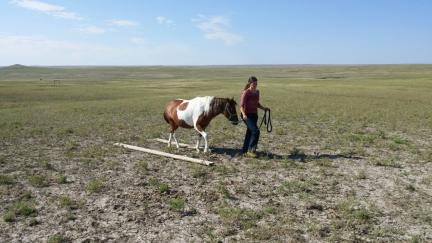
BOARDS ON THE GROUND - THE S - THE W- AND MORE
To Start. You can use any boards on the ground. Use just two boards and see how this goes. Keep them at least 4' apart and walk through them first yourself. Then Walk The Equine Through. Easy Does It.
more to come
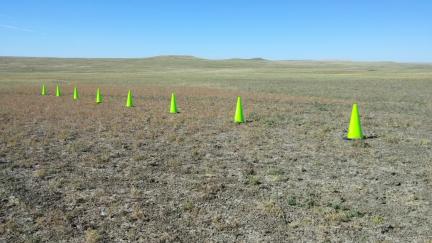
WEAVE POLLS and or CONES
Horses have been Weaving Poles in Competition as long as I can remember, and I am old. So these Pieces of Equipment should be easy for you to train your Equine.
My advise to you is to BUY the Best and as Many of Traffic Cones as you can afford. Ten is not too many.
Cones are great to start your Equine Weaving. They mark the "trail" well, better ones have heavy bases and will not blow over or around, and you can add Poles into the cones later. Most good cones have a hole in the top. Most of these holes will allow a Pole to be stuck into it. The better, heavier, cones will make good bases for Horse Agility Pole Weaving.
Every Horse Agility Club Course might call for different amount of Cones or Weave Poles for use in Competition. Some Clubs will want you to use Cones, others Poles. Some might ask for five to be set up, other Clubs might ask for eight or more.
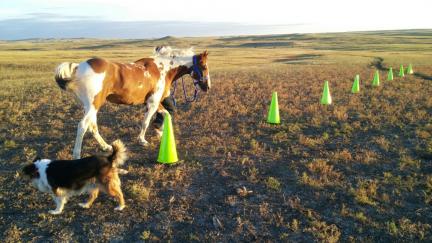
OF COURSE: Weave Poles can be set in the Ground, stuck in, or set up on Post Holders. We HIGHLY recommend putting your Poles into Stands. Post Holders are safer when "break away" or "falling", and easier to move about when the Agility Course Changes.
You can easily build holders for Posts or PVC Pipes for Weave Poles. (photos and sizes coming soon) You can use 2" x 4" wood or PVC Pipe.
Whatever you do make these safe for your equine. Tall enough for the animal to see them well. Moveable enough that if the animal spooks the trainer does not get squished into a pole.
BOX OF EMPTY CRUSHED WATER AND SODA BOTTLES ON A BOX
I am not going to lie to you, I think this is a ridiculous piece, not for Ground Training or for Trail Class, but for AGILITY? It has no place on the course...but it is there, in the On Line Competitions, so we will talk about it here.
Save your Empty Bottles and build a frame Box on the Ground to put them in (good luck not having them blow away outdoors) and have your horse walk through them.
I am not sure why Horse Agility became more of a "scarey, desensitizing Trail Class". That is NOT what Agility for Animals is at all. Except in Equine...it is quite silly to me.
IT IS GOOD TRAINING SOME OF THESE PIECES CALLED AGILITY, BUT ARE NOT. BUT THEY SHOULD NOT BE ON THE AGILITY COURSE....that is, in my Humble Opinion.
I am still looking for the sizes for these Boxes to be built. So....more to come
THE TUNNEL
We all love the Tunnels on Agility Courses. Mice to Equine. We all love to see the animals running through, that is, seeing them run in, and then come out the other side of, the Tunnels.
But what could you use for a BIG OLE EQUINE TUNNEL?!?
It depends on the size of your Equine. I have seen Minis using Large Dog Agility Tunnels. (train wisely) But for the average sized horse, you are going to have to build something.
more coming very soon
KICKING A BALL
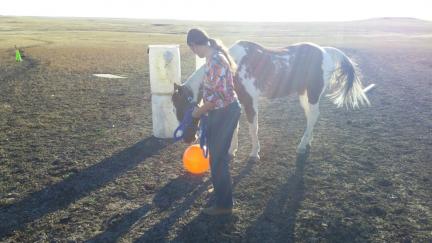
Kicking A Ball?????? On An Agility Course?????? But there it is. Right there on one of the Horse Agility Club's Agility Course....
I have participated in MANY species of Agility and Kicking A Ball? Never on a course. Good Training for an Equine? Yes. Cute for Trick Training? Yes. On An Agility Course? "Who would have thunk it?" But there it is. So here you go.
First of all you need a Large Ball. You need the RIGHT Ball for your Equine. It might cost you a bit to find out what that right ball might be. You might have to try several. You do NOT want a Ball with a Handle....some Equine can and are (mine included) to Fetch these for their Handles. Cute. But not what is asked for with this Agility Task. Believe it or not, there are many types of large balls one could use. Including many "Horse Balls" on the market today.
These photos are of the first day I introduced my Paints to the Play Ball I bought for less than $5 in the Toy Dept.
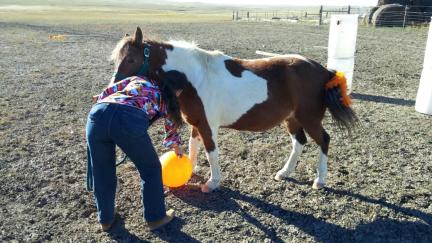
To train this "obstacle", I personally call this Trick Training. I took the Orange Play Ball out to the Agility Course. I had set it up in the middle between Agility Pieces and walked my equine past it a few times. They did not care about it at all. So. On the next pass, after several passes, getting closer and closer to the Ball laying on the field, I gave it a slight kick. My equine did not care.
I then set the ball in their pathway. I told them to kick it. Dream Maker, my Pony, stepped over it....many many times. When she finally made contact with the Ball, I praised and gave her a treat....each time.
Arrow, my Paint Horse, we raised from a Weanling and his training started with, during Ground Work, Tricks. So he took right to it, and when he heard the 'cue', "Kick It", he understood right away I was asking him to do something with the Ball. As soon as his hoof hit the ball, I gave the "good" and treated him....he got it right then. He will kick the ball each time I ask.
If you practice with your Equine you will be able to train it to kick the ball across a field into a soccer net. You could also teach your Equines to place a handle Horse Ball into a Basket and call it Basketball. Cute for folks to see, and not too hard to train. Horse Tricks are fun and fun for folks to watch the animals doing.
id= align=left
ADDING HOLIDAY DECOR
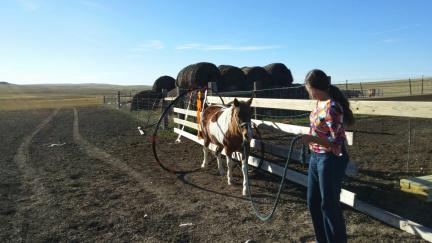
Any time you move or add to your Equine Agility Course, walk your Equine through before starting. Things will look different to the equine. If you add Holiday Decor, and you should from time to time, walk the Equine through and let him/her look and smell and touch before you start them heading through it at a faster pace.
An Agility Course SHOULD/SHALL be changed up, equipment moved around. It would be boring for the Equine to run the same Course over and over and over. And. It gives the "home team" an advantage.
For fun, and to "change it up a bit" add Holiday Decor. Which ever or all or the Holidays you want. It is not only fun for those on the Course, but fun for the Photos, and in time to come, not only a fun memory, but a reminder of when the photos were taken. By doing this, it also keeps the Human Team Member interested. Interested in the Sport, and having the fun of shopping for and setting up all the Decor.
TRAINING YOUR EQUINE TO EACH PIECE OF HORSE/EQUINE AGILITY EQUIPMENT
TAKE YOUR TIME TRAINING YOUR EQUINE. Don't get into a hurry to show off your horse on a big course. Take your time to introduce your horse to EACH piece of equipment.
Walk your horse around and near the piece several times, let the horse sniff/smell the piece and take it easy. After your horse passes the piece of equipment without fear or worry, take them over/through it.
Take your equine in both directions on each piece of equipment. Teach them from both sides of your body too. By working from both sides of your body, this might help on day on the trail, or in a pinch, for your own safety.
Always make sure you have your Agility Equipment Pieces spread out so that not only the Equine has room to manipulate them, but also so that the Equine can go into each piece from the front. Not sideways. The body of the Equine should be straight as it enters each piece of Agility Equipment.
ONE PIECE OF AGILITY EQUIPMENT AT A TIME.
Once your Equine has learned that One Piece of Agility Equipment well, add another piece. However, add the new Piece in FRONT of the first piece. That is. Teach a new piece, when the horses gets that new piece, then after, right after, walk the horse over to the piece it already knows well. This helps the equine to "end on a good note". To "End on a Good Note" is what a Trainer always looks, strives for, when training. (with any species of animals) This helps the animal to want to learn....Ending On A Good Note.
KEEP IT SAFE! KEEP ALL YOUR TRAINING SAFE ABOVE ALL!
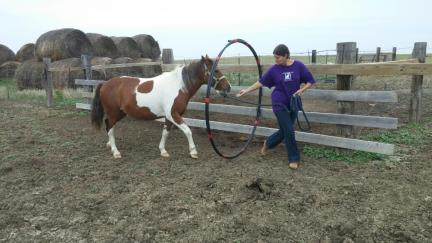
Start Large
Start with larger items. To Train the Hoop Jump I am using a larger Hoop that I made out of Black Hose and Duct Tape, found at the Hardware Store. I made it larger, so that Dream Maker and even our larger hoses and our donkey can step through easily. But making the Hoop larger, it allows the equine the room for comfort and it makes for easy access, giving the equine confidence in learning. I call it "Learning to Learn".
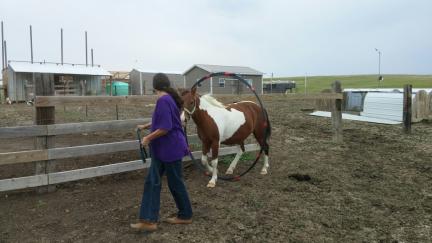
You also want to work your equine going through and over each piece of Horse Agility Equipment in both directions. Then later when or if you compete, no matter how the Agility Course is set up, your equine is already trained and comfortable with each each piece of equipment each direction.
Later I will make small and smaller Hoop Jumps, placed in Frames up off the ground more to make them actual Jumps.
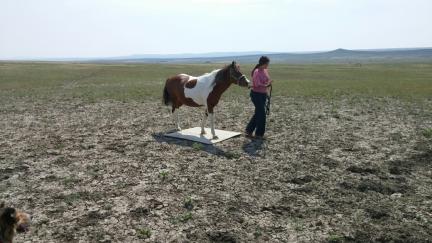
Start Low
When starting your horse on higher or built up items, start low. To me the Pedestal is probably the best piece of equipment to start your horse to get up on pieces of equipment.
When starting your horse to the pedestal...and other equipment they will stand on or walk over... PLEASE MAKE SURE ALL EQUIPMENT THAT YOUR EQUINE WILL STAND ON IS VERY STURDY AND NOT WOBBLY!
I use a flat piece of board to start training the equine to Pedestals or Bridges or anything they will stand or walk on.
Walk your horse all around the items on the ground. Walk so that your horse is on both sides of the item. Then after a few passes, YOU walk on just the corner of the item. Did that go well? If it did, in the next pass, walk a bit more on the item. Soon, after a few passes, YOU walk the entire item. On the next pass, have your equine walk just the corner, and so on. DO NOT GET IN A HURRY. Being in a hurry could set you back days of retraining.

Start Wide
Spread The Pieces Apart To Start
When you are working with Piece of Agility Equipment such as Two Barrels to Walk through, set the items up further apart then called for to compete, when you first start out.
As your equine is going through easier each time. Move the Barrels or other Agility Equipment, such as Board on the Ground or Open Tunnels, together each time you have a session with your equine.
If you equine is hesitant as you move the items closer, move them back a part just a bit.
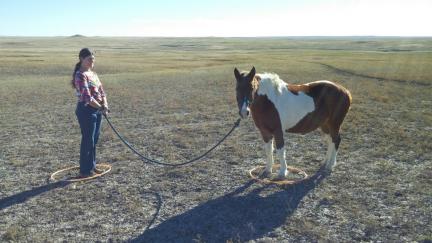
Start Close
In one of the On Line Competition Horse Agility Clubs they call for the Horse to Stand and Pause in one Hula Hoop while the Handler Stands in the other with the Hula Hoops 10' apart. You will need a longer Lead Rope for this.
Start with your Hula Hoops closer together when training. If you are closer, you can correct the Equine if it moves faster than if you are further away. Move the Hula Hoops further a part, little by little.
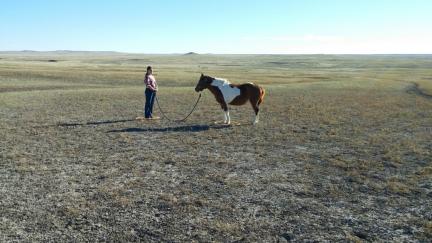
Also. When Training, have your Equine stand longer than the called for times in Competitions. Train your Equine to stand for the count of 15. Of course you will do this by starting at just Standing/Pausing for the count of 2 (seconds)...working up to the longer amounts of time.
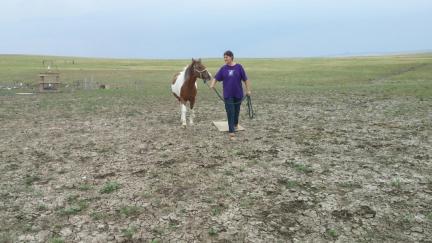
You Go First
As you walk around the course, casually with your equine, and you have a new piece of equipment, walk your equine on lead so that YOU can casually walk over or through what ever the piece is first. Do this a couple of times. If the piece is a board on the ground or tarp, walk your equine over just the tip of the corner the first time. If your equine wants to sniff or put it's head down for a better look, let them. If you take it slow, you will get further along faster.
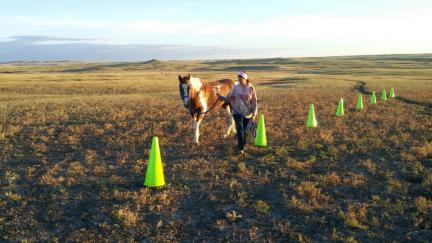
Start Slow, Keep It Slow
DO NOT GET IN A HURRY. Remember when you learned to type? Slow and easy, accuracy. Go Slow, Keep It Slow. Let your equine get used to the whole idea before starting the trot with your it.
If you hurry the process, if you start speed to soon, if you take the lead rope off to soon, you might find yourself starting the process all over again.
Just take it slow and have fun at it. We all want those loose/off lead/no halter equine running beside us, but make sure it works out for you by starting and staying slow and easy and get that foundation training in on your equine first.
Stay Calm
don't get excited or in a hurry or upset...more to come
Don't Get Cocky or Over Confident
Getting Cocky or Over Confident will bite you....more to come
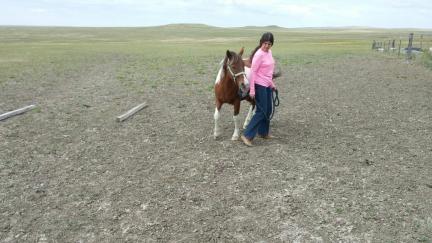
Loopty Loop - Circle Round
If something goes wrong, if the horse side steps, or refuses an obstacle, don't get all rirled up, don't correct with a slap, just calmly Circle the Horse Around and go at the obstacle, the same one, again.
more to come
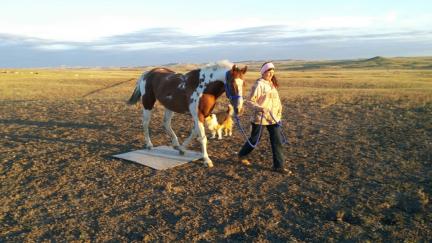
Don't Talk Too Much
When you are working with an animal, any animal, DON'T TALK TO MUCH! Animals will tune you out if you chatter.
You want to have cue words when working the animals, think Dog Obedience. There is the word, "heel", "sit", "down", ext. Find words similar to these and use them as you lead your equine so that they learn what it is you want from them.
For instance. Call the Pedestal "Pedestal", and when you want the front two feet of your horse on it say something like I do: "Pedestal - Fronts"
You want to Name the pieces of Equipment and say the Name of the Equipment to the animal as you work it.
You want to PRAISE FOR GOOD BEHAVIOR! Words. Don't always give an equine a treat. Never start giving a treat for each behavior. When you first start out and the equine manipulates a piece of equipment, praise and give a treat. the second time, give a treat, the third time, just praise. After that, give a treat now and again, but not every time. Soft WORDS are an encouragement to animals just as they are for humans.
Name The Pieces
Name Each Piece Of Agility Equipment and Say The Name As You Take Your Equine Through It
If you want your Equine to Learn, really Learn, like I said above, do not talk too much as you work your animals. However, Praise....and as you approach each piece of equipment, as you enter into it that is, say a one word name for the piece.
Call them whatever you want. Just make sure each work is very different from another. As You Weave the Poles, you might use the word, "Weave". But don't use the word "Squeeze" for the Tight Spaces. Use a word like "Tight". Weave and Squeeze sound too much alike.
Also, call each of your Jumps by a different name. Use One Word. Like "Hoop" or "Flower" and or "Cavaletti" and such.
Call your Teeter Totter, just "Teeter". Call your Rocking Horse just "Rocker".
One of the reasons you want to name your equipment pieces is that it will cue your equine where you are headed next. When speeds are taken up, this will matter. It will help guide the horse.
Naming gaits is something we do when we train our equine to saddle. Yes. They sure do learn this. And because of this, it helps on the ground. It can also give the equine confidence when working with you, it will not only read your body language, but hear the words too.
Let Your Equine Learn By Watching
Animals like people learn from watching others. Honestly. Animals learn by watching other animals perform the tasks (good behavior) and getting big ideas (bad behavior) by watching other animals.
If your Equine is new to Agility or if you are having trouble with one Agility Piece of Equipment, take your Equine, on lead of course, and follow someone with an Equine that goes over the piece easily. Sometimes, if the animal (of any species) sees another do something.....and not die....then the first will try it too.
Seeing the first animal doing the task (or getting big ideas) the first will just follow suit.
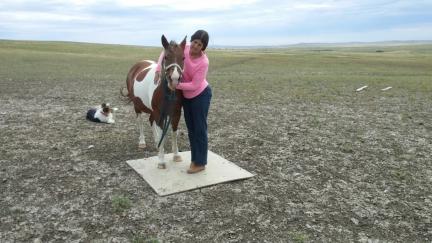
PRAISE! PRAISE! PRAISE!
Use your VOICE and tell the animal "Good". In a nice, upbeat tone. THIS is what we all live for. That Praise, That Approval. Don't keep talking, don't chatter, just give a "Goooood!" and walk on.
And once in a while, Pause and Praise with a nice pet or pat or rub. Then start again. I believe that animals pay better attention if they do not know when the petting and praising might happen. They watch you better. Better than what? Better than walking with a drone. Better then if it is the same, same, same. Mix it up and stop and praise.
more coming soon
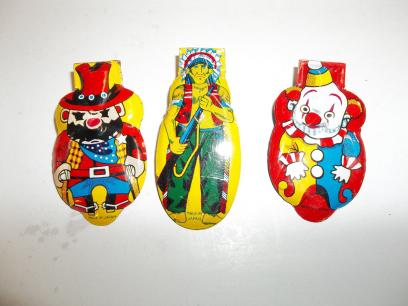
CLICKER TRAINING
I am NOT a fan of Clicker Training. Clicker Training was developed for Water Animals, dolphins, whales...I used tapping the side of the tank when I train Goldfish or Betas. www.fishagility.com
Your Equine however can hear your voice, use it. Use it to cue the animal as it is working. Drag out your word "Gooooooood" as the animal is "almost" correct. Use sharp "NO!" for/when wrong or especially dangerous moves.
Clickers were nothing but a Toy when I started training animals. Have you ever been to a Dog Training Class where the Clickers sound like crickets? And lots of them going off here and there and there and....use you voice. It is unique to your animal. They need to know it and mind it.
I know a lot of people depend on that clicker for animal training. If it works for you, use it.
SETTING UP A HORSE/EQUINE AGILITY COURSE
If you have ever set up a Dog Agility Course you know that it takes a lot of room and the amount of needed steps between pieces of Equipment is always put into the math equation for setting up the Agility Course.
You are going to need a Tape Measure with at least 35' marked on it. You will want to carry this in your pocket as you set up the Agility Course.
Horses are, of course, large animals with long gaits. Keep in mind they they need room between each piece of Agility Equipment and set your course up accordingly. For example, for Horses, your Weaving Poles or Cones need to be at least 10' apart, 12' is better for an average sized Horse, and called for by some Horse Agility Clubs Standards. (Set Cones closer for Ponies and Minis, of course).
There needs to be space between each piece of Agility Equipment. The Equine needs to gather it's gait and be facing each new Piece of Equipment before attempting/manipulating the next Piece of Agility Equipment.
Always make sure you have your Agility Equipment Pieces spread out so that not only the Equine has room to manipulate them, but also so that the Equine can go into each piece from the front. Not sideways. The body of the Equine should be straight as it enters each piece of Agility Equipment.
You also do not want, for example, Jump, Jump, Jump, Jump, then a Bridge and...
What you want is a flowing course with room between and change ups. Change ups means, for example, a Jump, maybe Weave Poles, then on to another Jump, over to the Tunnel, with a Pause on the Pedestal.... Flowing. Keep the Agility Course Flowing without over stimulating the animal (of any species).
Watch you corners. You don't want your equine coming to a Jump from a curve. When you have your Equine coming out of the Figure 8, give them room, on the Horse Agility Course, to straighten out their body and take a few steps before going into the next Piece of Equipment.
Yes. When you set up 10 Pieces of Equine Agility Equipment you ARE going to need some room. It is better to only use 4 pieces of equipment than to crowd 10 pieces in and have a cramped, unsafe course.
more to come
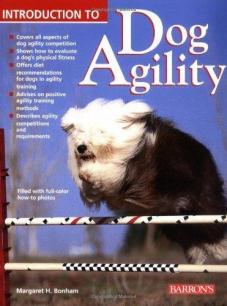
If you want to really know about the Sport of Agility, pick up an older copy of a Dog Agility Book (not necessarily the one in the photo) where the writers go into details about how the animals see and work the course. See how the Courses are set up, equipment being in the correct places for the flow and safety of the animals. See how the dog people keep it fun and mostly safe.
Apply that knowledge to Equine Agility. While a horse is not a dog, and you will train your equine a bit different, read and learn the basics. Dog people have been enjoying Agility for several years now and "have it down pat". The dog people keep it safe and fun for their animals. But they also keep it exciting, fresh and new!
There are also some Horse Agility Books on the Market now too. But those Dog Agility Books will teach you all the basics of the Sport in general and are worth the read for the person that is really interested in Agility as a Sport.
COMPETITION ~ ON LINE AND IN THE FLESH
There are two ways you might Compete in Horse/Equine Agility. One is to find a place near you that offers the competition...Good Luck.
There are also On Line World Wide Clubs that offer Competitions for folks that take a Video of their equine out on the course. The course is of course set up by the Club and you set yours up as they direct you to do. Enlist a friend or family member to video you...after much practice....and off you go! One Club I saw on line has Monthly On Line Video Competitions with Prizes.
You can go online and search the Information and join clubs, buy books and have a great time!
Just as in Dog Agility when it first started, there will be more Horse and Equine Agility Clubs that set up. Each will have it's own type of Equipment and Set Of Rules. You of course can join the Club you would enjoy most, or join and participate in all you can find.
Competition pushes us all forward. It helps us become or try for our very best. I see Competition as a very good thing. I also see the start of MORE Horse/Equine Agility Clubs as a very good thing. I am looking forward to enjoying Horse/Equine Agility for many years to come...and with others that enjoy the same sport I do.
THE BENEFITS OF PARTICIPATING IN EQUINE AGILITY
There are so many benefits to participating in Equine Agility, for both the equine, and the human. I could create a very long list, but let me just hit some of the highlights...
Bond With Your Equine
Great Ground Training
Build Your Equine's Confidence
Help A Spooky Horse Overcome Some Of It's Scares
Get Those Out Grown Ponies On Pasture Flowers Working Again
Cart Training Equine Helps
Cross Training
Horses too Young for or Retired From Saddle Work
Increase The Value of Your Horse or Increase The Value of a Horse You Have For Sale
Agility Is Just Fun for BOTH Humans and Equines!
much more to come
HOW AND WHEN TO GET STARTED
The first thing I would say to a person that wanted to start their equine with Equine Agility is to do your research. Look around the Internet and see all the different ideas and see all the information.
What I am telling you here is what works for us. I say and say: What Works For One Person May Or May Not Work For Another.
To get started in Horse Agility. The very first thing you need to do is set up one easy piece of Equipment. One. Take your Equine Companion out to that One Piece and have them walk up to it. Have them walk around it. Do this a couple of days, if needed more, and THEN and only then, start your equine on that one piece.
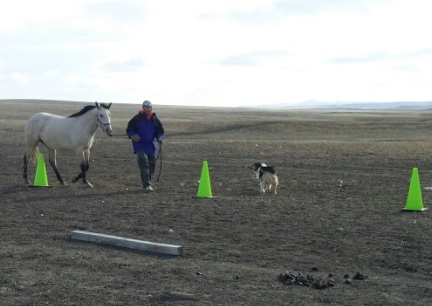
THIS IS ASSUMING YOUR HAVE AN EQUINE THAT WALKS QUIETLY WITH YOU ON A LEAD ROPE. IF NOT....THAT IS WHERE YOU SHOULD START.
DO NOT HURRY YOUR EQUINE INTO OR PUSH YOUR EQUINE SO FAR THAT THEY DO NOT ENJOY AGILITY. Slowly, Slowly, Slowly, at your horses pace, Train. It is suppose to be fun for and safe for both you and your equine.
Make sure your equipment is set up for the equine's size. This is a photo of d'Artagnan (Dar-Tan-Yon), it is his first day (with us anyway) on cones. I set them up at 12' apart so that not only did he have room to work and think... setting your cones up, with a measuring tape, gives the horse rhythm, horses seem to like rhythm, it seems to calm them.
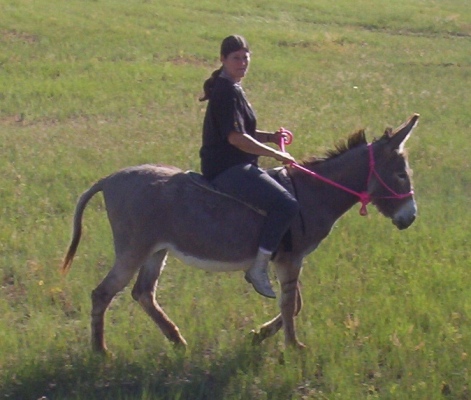
A FEW WORDS ON DONKEYS AND MULES!
Donkeys and Mules are not really Stubborn like people think they are stubborn. The average, make that most, if not darn near all, Horse People have no idea how SMART Donkeys and Mules are. When a Donkey or Mule understands what you are asking, they bore doing it over and over and over again. Like running around in a circle in a round pen. They already did that, they are ready to move on. Don't hurry their training, but if you treat them like a Horse, which they are not, they will act in a way you might call, Stubborn.
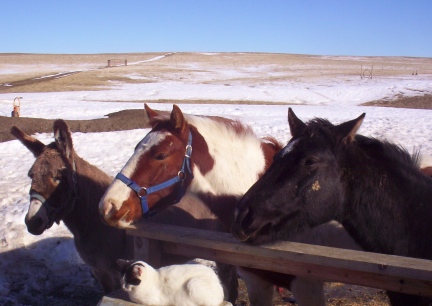
But My Horse Is Afraid of Donkeys and Mules! If your Equine is "afraid" of other types of Equine or other Animals, maybe THAT should also become an obstacle to over come with your Equine.
These mugs are lined up at our Front Porch looking for treats. Yeah, they might be a bit spoiled.
If you look in the background of this photo you can (barely) see our Dog Agility Course.
KIND WORDS WORDS AND LOTS OF PETTING AND PATTING
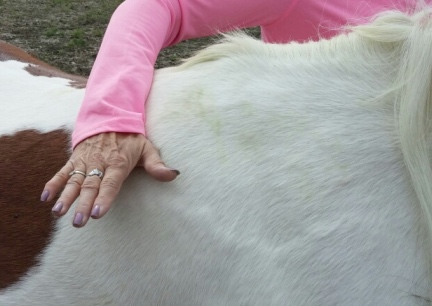
When you are training an equine, (dog, cat, mouse....) they hear your voice, they see your face, they read your body movement, and they like to hear their names with kind words. They also like a pat or petting. They, like children, or other animals, like to please you, to know they have pleased you, to "work for reward".
I have heard a few Horse Trainers say that Equine do not like Patting. Maybe, their Pat is not a Pat at all, but a Hit or a Slap, or call it a Pop.
There is a difference.
A PAT is nothing more than a hand LIGHTLY making contact with the body of another live mammal. And Yes. NO ONE, not human or animal, likes a HIT, SLAP OR POP. That is what some call a "Pat" you can hear. But a soft pat. One you can not hear. I have never owned an animal from a cat up in size, that did not like a light soft Pat.
A Pat is from the wrist. Your arm stays on the animal, the hand bends at the wrist for a soft Praising Pat.
HORSE TREATS
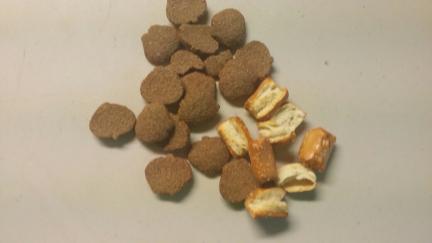
I do think Horse Treats should be used, but not overly used, when training equine to do Tricks and or Agility.
Equine Treats should be small. When you give them to your equine they should be eaten and gone in a couple of chews. Otherwise, it will hold up training. Large treats, very hard treats, need to be chewed and chewed and chewed and chewed. What you want is a sliver or a carrot or such. There are small horse treats on the market, about the size of a Half Dollar, THIS is what you want for your training treats.
Treats are NOT given each time your equine dose something correctly...They are given the first time an animal does a correct behavior, then again when the animal does the same correct behavior. But the next time, no. Later when the Equine does performs correctly again, give a treat. ALWAYS GIVE A VERBAL "GOOD!" As the training progresses, the treats diminish till the full performance is performed. That is. Do not give a treat for every piece of Agility Equipment. Do not give a treat at the same place on the course over and over. The idea is that the animal never knows when that "Good" is going to produce at treat in their mouth. But the animals knows, with the word, "Good!", that is is performing correctly and a treat is coming.
Do NOT let your equine decide when the treats will be given. A Stop and Won't Go is NOT the time to use a treat. Do not reward BAD Behavior. ONLY use treats to reward GOOD behavior.
Use Treats sparingly, but everyone wants that reward. That paycheck is why we humans go to work. See the Treat as your Equine's paycheck.
IF YOU HAVE A PUSHY ANIMAL, DO NOT USE FOOD TREATS. IT COULD BECOME DANGEROUS AND YOU MIGHT BE STARTING AGILITY TRAINING TO SOON AND NEED TO GO BACK TO LOUNGE AND GROUND TRAINING. YOUR ANIMALS SHOULD RESPECT YOUR BODY AND YOUR SPACE.
GROOM YOUR EQUINE
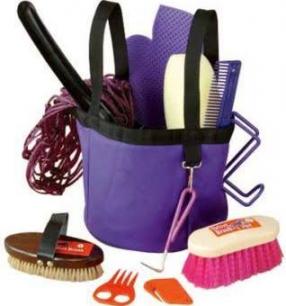
EVERY HUMAN loves to have their hair brushed and or their head rubbed...back, feet massaged... you get the idea.
EVERY EQUINE (broke out and in the process) loves to be brushed. In fact I am a big believer that Grooming Your Equine BEFORE AND AFTER A RIDE...WILL GET YOU A BETTER RIDE!
Try this. Groom your Equine BEFORE and AFTER you Train for Agility. Get out your horses/equine brushes and give that animal a good going over, talk nice to them as your groom. See if your animal does not stay closer to you and listen better after you start making Agility even more rewarding!
Each of your equine should have their own Grooming Tools (and tack). They should not share. Equine do get lice and mites and sweet rash, and it is/can be spread using the same tack and or grooming tools on multiple equine.
I know people that have had to deal with "break outs" within their entire stables. Believe me when I tell you it is cheaper for each of your equine's to have their own Groom Tools and Tack, then to deal with some of the "plagues' that sharing them can have.
I color code my tack and grooming tools per horse here. They each have their own colors. I keep their Grooming Tools in separate containers and keep them apart from the other equines.
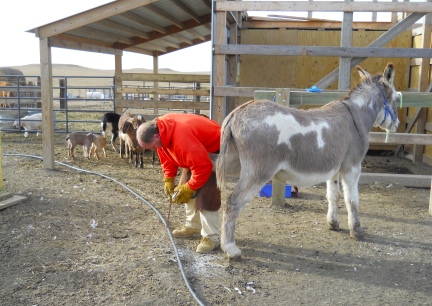
Hoof Grooming Matters Too! You are asking your equine to run and jump and go over and under and through equipment. Make sure their hooves are trimmed well, correctly, and or your equine's shoes are on and fit correct! A loose shoe could mean a hurt horse and or human...if it were to get caught in a piece of equipment.
Hooves taken care of correctly also will mean comfortable feet for your equine as it performs....
PLUS IT LOOKS SO MUCH NICER IN PHOTOS AND VIDEOS.
AND ON GROOMING, THERE IS THE HANDLER How many times has a photo been taken of a beautiful horse and the handler is in their Barn Clothes? I know. I know. When we work our horses we need clothes that can get ruined. I get that. But now and again we also want nice photos and or videos....Dress For It.
This is especially important for when you are competing. It not only says that you care, it shows respect on the course...whatever course that might be.
THAT SAID: A PHOTO OF YOUR EQUINE WITH MUD AND YOU IN BARN CLOTHES, IS BETTER, IN YEARS TO COME, THAN NO PHOTO AT ALL. I know this from experience.
WILD AGILITY!
Wild Agility is training your horse to Natural Agility Equipment. That is, training your horse to Weave A Tree Line, to Jump Logs, Ride Along Water Shores and such.....
Unfortunately for me. We have no trees. I know. It is so weird. It sure took a while for us to get used to. We had so many trees when we lived in MO and more even when we lived in WI...then we moved here, where you can see for miles and miles and miles....cause there are no trees!
If You Train In the Woods
There is no such place as "In The Woods", as if it were a place of magic where you can play and camp and cut Christmas Trees. If you do not own the woods you are working in, someone does. DO NOT JUST GO ONTO SOMEONES PROPERTY AND START USING IT FOR YOUR TRAINING GROUNDS. Ask Permission and if they say, "No." Do Not Train There!, Do Not Be There!
Be careful and do not train alone in the woods with your horse.
Keep your Equine on a Lead in the Woods, at least when you first start training there.
more to come....
PHOTOS AND VIDEOS! TAKE A LOT!
I say this because I am really bad about it.
Take a LOT of photos and videos of your equines. Take photos and videos of them working and you riding them, and of course, while on the Agility Course...that is learning and competing.
I tell you from years of experience and disappointment (that I did not take enough or too few) TAKE PHOTOS!
One day your equine will be gone. You will wish you had those photos and videos to look at. Plus the fact that some people just won't believe that you had an Equine that Performed Tricks and or Agility. Photos, my Dear, Photos!
One day you will be old. One day you will love to sit and look at and or show off all the photos of you and your equines and the things you have done.
FREE EQUINE/HORSE AGILITY EQUIPMENT!
If you look around there are items you can find for FREE to use for Horse/Equine Agility. What are some of those items?
Car Wash Barrels; Even the 30 gallon barrels can be used. Below you will see and find out how useful a Barrel can be. They can be used as is for some of the Agility Equipment and drilled to make other types. If you had 12 Barrels, and the time, you could set up quite an Agility Course. Barrels prepared correctly could even become your Agility Arena.
Wood From Work Sites;
Many times when Public Places add on, or do some work around the buildings you might find perfectly good pieces of lumber in the trash cans. Ask first. Make sure the wood is good before removing it. Make sure it is large enough for what you want to use it for. You might also find Orange Fencing that could be used for one thing or another, like a "Scarey Corner", when working your Equine with Agility.
Old Tarps
Most Farm and Ranches have an Old Tarp laying around. Just make sure that if it has holes in it that a foot could get stuck inside of, you trim it down. Make sure it can be pulled tight to use for the Equine to Walk Over.
Logs and Branches
Logs and Branches can be used for Jumps, to Hold the Tarp, for Boards on the Ground for the Equine to Walk Through and more.
Make sure these come off your own property or that you have permission to gather them.
If you are cutting these off YOUR OWN trees, make sure you know what you are doing. Keep it safe.
Old Hoses
Old Hoses can be cut and made into Hula Hoop Sized Hoops to Stand in. You will need two.
Car, Truck and Tractor Tires
Old Tires can be made for many things in Equine Agility Equipment. From Pedestals to Jumps to Stands for Equipment. Tires can be very useful. Just keep in mind that old tires hold water/rain and when the sun heats them this is where Mosquitoes and other insects like to lay there eggs.
Wooden Shipping Pallets
Far and Few Between there are some Wooden Pallets that, with work, would work for your Equine Agility. These are the Heavy Built, 2" x 4" new wood, or larger. Some are made heavy. Most are not.
The Wooden Pallets with the thinner wood. NOT WORTH THE WORRY OR PROBLEMS THEY COULD CAUSE FOR EQUINE AGILITY.
Wooden Pallets, soooo much you can do with them, make with them, decorate with them. But for the average Wooden Pallet...NOT STRONG ENOUGH FOR AN EQUINE! NO. NOT REALLY EVEN A MINI!
However. That said. You could make an Arena with upright Wooden Pallets, it will take some work, and might now look that nice when you are finished, but you could use them for this.
Do NOT Steal Traffic Cones!
Traffic Cones are used in Construction Areas for the Public's Safety. DO NOT REMOVE THEM! Imagine how terrible you would feel if your own family member or friend were hurt or killed because you thought it would be alright to steal "a few cones" from the Roadway.
Even those Traffic Cones set off to the side of the road, when the work is completed, belong to someone else. They are NOT left there for people to Steal for their own use.
You can now easily and affordable buy Sports Cones.
Flags
Cut up old Clothing. Place them on a Stick.
CHEAP/INEXPENSIVE HORSE AGILITY EQUIPMENT
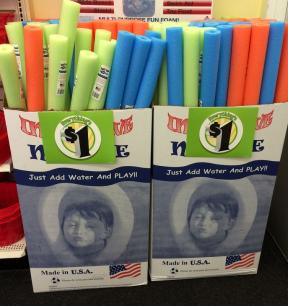
Hula Hoops
Did you know you can still purchase Hula Hoops, here in the USA that is, for $1 each? Yes. You can. Try the Dollar Tree. While you are there, look around. You might be surprised what you will find.
Pool Noodles
I bought my Pool Noodles when I was at the Dollar Store looking for something else. When I saw them, for $1 each, I bought them. They seem to sell very quickly, there is so much you can do with them, and I wanted to get them ALL in the Lime Green to match my Horse Agility Course.
These can be used to make so many types of Horse Agility Equipment. Not only are these inexpensive, they are pretty safe to use with Animal, of any species, Agility Equipment as a foundation.
Holiday Themed Course Items
Have Fun and mark the Seasons with Holiday Items on your Agility Course. You can find inexpensive items at many stores, including, again, the Dollar Tree....no, I don't work there or own stock in the store.....I probably should.
Small Sports Cones
Small Sports Cones are better than NO Cones. Small Sports Cones can not only be used for Weaving, but also to mark areas. One Club used a Obstacle called "Scary Corner", Small Sports Cones could certainly be used in here to hold flags or mark the Corner.
Blue (or Brown or Green) Tarps
This is another "obstacle" with one of the Horse Agility Clubs. They use it for walking over <?????, yeah, I am not getting this is for Agility, but it is what they ask for> These smaller sized Tarps can be bought in Hardware Stores pretty cheaply.
Flags and Pennant Rope
One Club also asks for Flags on their courses. I picked some up for FREE outside a large Hardware Store, the type they use for stapling to wood for travel. You can also buy Flags and Flagging Pennant Rope, pretty inexpensively in Hardware Stores or On Line. I bought a few 100' Pennant Ropes, in different colors, for less than $9 delivered.
Wood For Building
Many of the Hardware Stores have a place they put "not so perfect" wood pieces. Some large, some not. Many times they sell these for pennies on the dollar. There is no reason a lot of this wood could not be used to make Jumps or other Agility Equipment.
more to come
The contents of this page for Equine Agility is still under construction.
So please: COME BACK OFTEN AND CHECK IN ON OUR HORSE/EQUINE AGILITY PAGE HERE AT THIS SITE
Please Join Us on a Couple of Yahoo Groups I Host:
-- The Does My Butt Look Big In The Saddle Team
Tue, 18 Aug 2015 15:21:06 -0400
| 



 In the high plains of South Dakota, USA
In the high plains of South Dakota, USA In the high plains of South Dakota, USA
In the high plains of South Dakota, USA